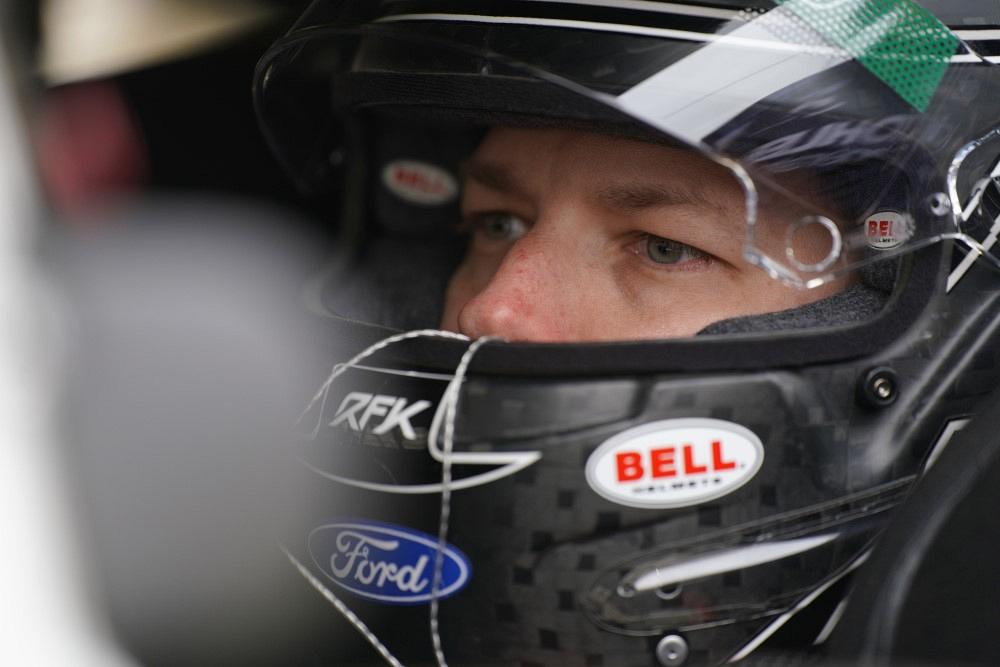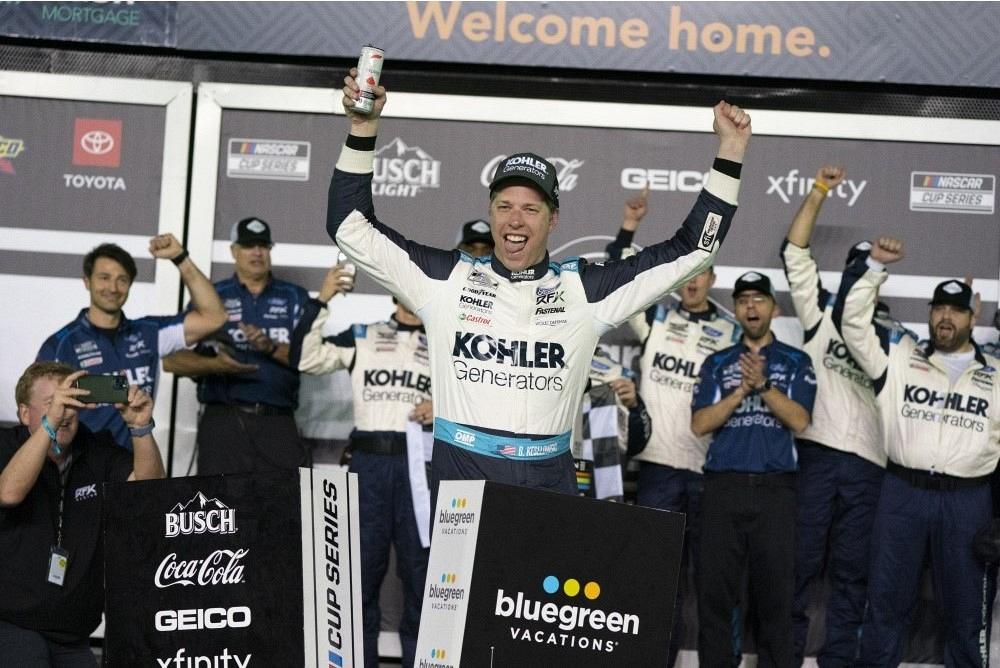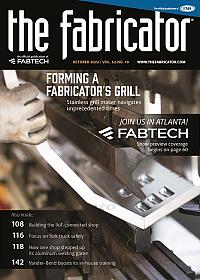Contributing editor
- FMA
- The Fabricator
- FABTECH
- Canadian Metalworking
Categories
- Additive Manufacturing
- Aluminum Welding
- Arc Welding
- Assembly and Joining
- Automation and Robotics
- Bending and Forming
- Consumables
- Cutting and Weld Prep
- Electric Vehicles
- En Español
- Finishing
- Hydroforming
- Laser Cutting
- Laser Welding
- Machining
- Manufacturing Software
- Materials Handling
- Metals/Materials
- Oxyfuel Cutting
- Plasma Cutting
- Power Tools
- Punching and Other Holemaking
- Roll Forming
- Safety
- Sawing
- Shearing
- Shop Management
- Testing and Measuring
- Tube and Pipe Fabrication
- Tube and Pipe Production
- Waterjet Cutting
Industry Directory
Webcasts
Podcasts
FAB 40
Advertise
Subscribe
Account Login
Search
Brad Keselowski on his season of significant change, expanding into advanced manufacturing
Cross-training helps manage ups and downs around the track and Keselowski Advanced Manufacturing (KAM)
- By Kate Bachman
- October 18, 2022
- Article
- Additive Manufacturing
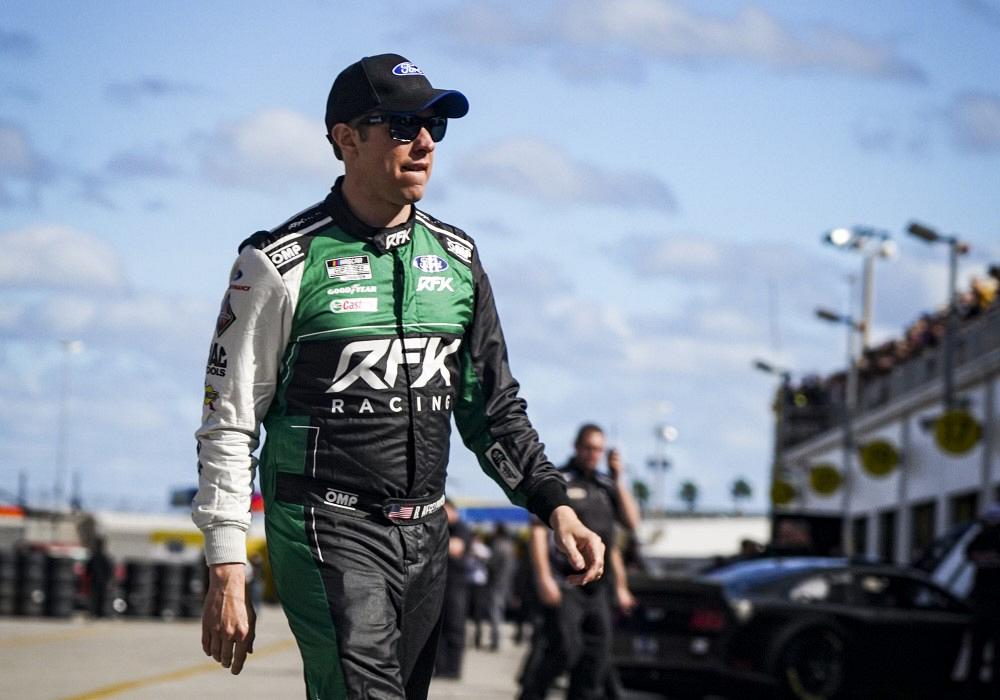
Brad Keselowski is a NASCAR Cup Series Champion race car driver; co-owner of Roush Fenway Keselowski Racing; and founder, owner, and a pioneer in advanced manufacturing with Keselowski Advanced Manufacturing (KAM). He launched the company in January 2019.
Brad Keselowski knows deadlines as well as finish lines, the feel of steel, and the feel of the wheel. He races; manages an advanced manufacturing business, a racing team, employees, and a crew; and knows how to hitch Barbies to pink Power Wheels.
Keselowski is a NASCAR Cup Series Champion race car driver with a hall of fame-caliber career; co-owner of Roush Fenway Keselowski Racing (RFK) – one of NASCAR’s preeminent teams—founder, owner, and a pioneer in advanced manufacturing with Keselowski Advanced Manufacturing (KAM); and “full-on girl dad.”
All of those experiences have provided cross-training to improve his performance in each arena.
Metal forming and fabricating manufacturers will have the opportunity to hear Keselowski in person at his keynote address, Winning the Manufacturing Race, at FABTECH 2022 in Atlanta on Wednesday, Nov. 9 at 9 a.m. Keselowski will share key insights on how his NASCAR experience and his passion for technological innovations led him to launch KAM.
This was a year of significant change for Keselowski. For 12 years, he had been a premier driver for Roger Penske where Keselowski helped Team Penske earn a total of eight NASCAR championships from 2010 to 2021. He left in 2022 to drive for Jack Roush and John Henry and took an ownership role in their team. Keselowski said he is focusing on igniting the team’s competitive spirit with a renewed culture and direction. Going from a race leader at Penske to playing a catalyst at RFK is only one transition for him. If that were not enough excitement, he simultaneously expanded his advanced manufacturing firm too.
Keselowski has had his share of tumultuous experiences on the track throughout his 18-year racing career. Last year at Daytona, Keselowski and his then-teammate Joey Logano were racing for the win on the final lap of the 500 when they crashed only two turns from the finish. Keselowski’s car was totaled, and within seconds he fell from a possible historic 500th win to 13th place. At the Bristol Motor Speedway on Sept. 18 this year, Keselowski led the field for 109 laps and was holding a comfortable lead when a flat tire knocked him out of the race 87 laps from finish. Just recently at Talladega, he was in a lead position when a speeding penalty on pit road knocked him out of a potential seventh win at the Speedway.
Although Keselowski’s blown tire took him out of the Bristol race as a driver, his RFK teammate and team driver Chris Buescher took first place. This was the first race win for the RFK team since 2017. Similar to the positive impact Keselowski has had on his previous NASCAR teams—JR Motorsports, owned by fan-favorite Dale Earnhardt Jr. and Team Penske—he's made his mark at RFK right away.
Over the years, Keselowski has learned how to adapt, adjust, and roll with the changes. Metal fabricators, stampers, welders, and finishers, who are no strangers to change and disruption, may be interested in how Keselowski has learned to apply cross-training to maintain equilibrium.
Here are some insights he dropped pre-tradeshow.
How do you handle those rollercoaster-ride occurrences throughout a race?
Keselowski: Well, motor sports will hurt your feelings, and so you’ve got to check them at the door as much as you can. Certainly, you still want to be passionate and, yeah, I definitely got my feelings hurt a little for a short period of time at Bristol. That’s part of the highs and lows of racing.
But, you know, you have days like that, and then there are other days when you're running second to fifth, things go your way, and you end up winning. So, you take them in stride over the years.
You can't control all of your final destiny. All you hope to do is be in position. I am really proud of my team, and I'm thankful that we are doing the right things so that we can be in position.
What strategy do you have to maintain equilibrium throughout events that you just cannot control?
Keselowski: A lot of training, a lot of reading. Some of it is time and experience and just getting more comfortable with knowing that that's part of life. Leadership training's been really helpful for me, to be honest, on how to control your emotions. So, I put a lot of time into that. Those are probably the biggest keys, I would say.
Does it help that you had those huge successes already? That you won the Cup Series in 2012?
Keselowski: That does help roll some things off your shoulders, no doubt. But it doesn't replace the fact that I want to win right now, too.
How did it feel to win as a team owner rather than a driver?
Keselowski: Thankfully, with the team ownership role, I still won—not as a driver, but as the team owner of the car that won. So, that was really a shot in the arm. I'm really proud of Chris Buescher and everyone at RFK Racing.
That seems to kind of reflect a shift from your early days as a very young driver. How has being a team owner changed your perspective?

This season, Keselowski left Team Penske in 2022 to drive for Jack Roush and John Henry and took an ownership role in their team, now called RFK Racing.
Keselowski: I've got more opportunities to win. I can still win as an owner, which is good. But it also means I can lose twice.
The ownership perspective is you get to see it from the people side more than you probably do as a driver. It takes a team of almost 200 people to service our two cars. You recognize that there's a team of almost 200 people who are working their butts off to make things happen. And we travel across the United States, 36 races a year. We have to have cars ready. They'll run the race without us. Not only do we have to show up to the racetrack, we've got to have great cars and great people once we get there. So, it's a full-on endeavor for sure.
You see all that come together—for the highs and lows as well. Knowing that you're a big part of making sure it stays together, and that the words you say carry a lot of weight—for good or bad. You learn a lot of lessons through that journey.
As a team owner, you’re using a different set of muscles. How do you develop them?
Keselowski: The brain power is a little different for sure. For me, again, it's been a lot of leadership training and studying and time. I have two young kids, and so I probably have developed the patience that comes with that as well.
What drove you to take this next step in your career?
Keselowski: I want to be a part of the sport for years to come. As a driver, you're kind of perishable fruit.
As I looked at the sport and how it was growing, I realized that this was a unique window and time for me to solidify my position in the sport as something more than a driver … to leave my stamp on the sport; to turn a team around and help make it successful.
So, I just thought it was an incredible opportunity. You don't get those all the time in life. You're defined by the moments that you take, even the ones you miss. So, I didn't want to miss this one.
Why did you want to join Roush Fenway, in particular?
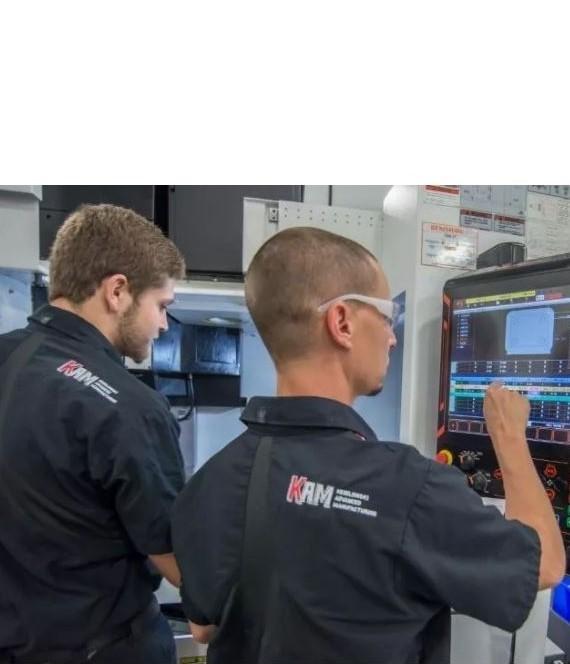
Keselowski Advanced Manufacturing (KAM) emphasizes cleanliness in its shop because people don’t want to work in dirty factories, said owner Brad Keselowski. Brian Lipchik/FMAC
Keselowski: The pedigree was there. The resources and assets were there that are needed to build, be it sponsors and things of that nature.
How do you rebuild a once-great team?
Keselowski: It's a journey of love and a journey of pain. It starts with culture in everything we do.
And then trying to move the company forward. Very little work was done using computers. My challenge is to get RFK to be not an Industry 3.0 company, but an Industry 4.0 company.
Workflows are everything. The terms Industry, 2.0, 3.0, 4.0—really those are workflow conversations, in my opinion. If you look at the Industrial Revolution, each marker is about how do we do things faster, cheaper, and with higher or equal quality to the ways that we did them before.
I haven't had all the success I want to have to date, but we're building something from scratch—which is a lot of fun but also can be frustrating. We're setting ourselves up to be successful for years to come.
With NASCAR’s Next Gen car model requiring that each team use the same prefabricated components, how do you stand out when there is so much required sameness? How do you excel within those constraints?
Keselowski: You find the margins that you can work in. They're out there. You have to search for them every day—the driver, the pit crew, or little tweaks on the car that are open for you. That's how you excel. You find the opportunities. Don't get me wrong, there are fewer opportunities to work on the next-gen race cars than there were in decades past. But I think it's real easy in life to get caught up on your constraints and lose sight of the opportunities. And so, we try to focus on the opportunities and not the constraints.
There seem to be a lot of malfunctions with the Next Gen car this season, like force-of-impact injuries, oil fires, and blown-out tires. Do you think that these safety issues can be resolved quickly, or will it take more extensive modifications?
Keselowski: We're experiencing a massive engineering challenge in NASCAR right now. We've brought out a new car that has a lot of strengths to it, but there're some tradeoffs to those strengths with weaknesses. We have seen some fires and injuries. Some are the bugs that happen with any new product when it comes out. Do I think they can be resolved? Yes, absolutely. Will it be with a snap of the fingers? Probably not. There are a lot of pieces to work through.
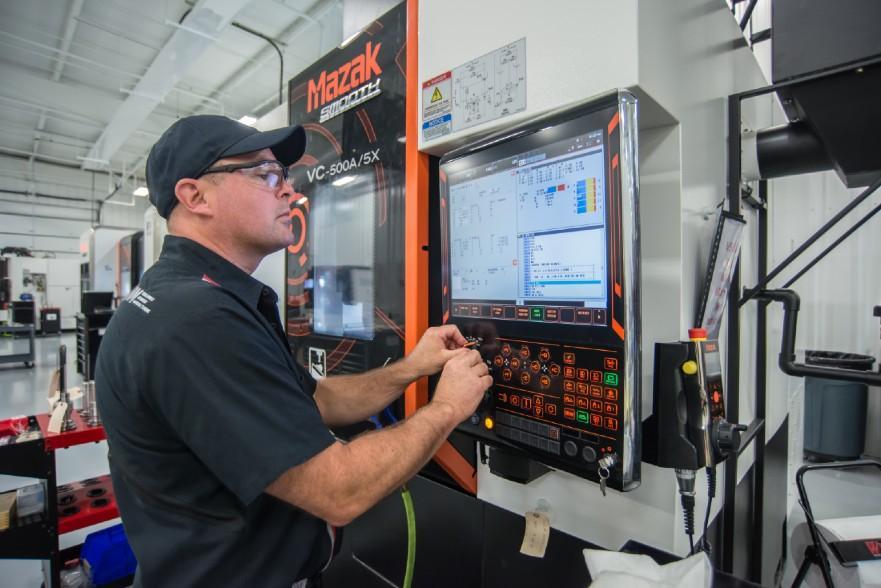
KAM’s equipment includes seven metal AM systems and eight CNC machines, as well as an extensive array of software, metrology and powder analysis equipment, and postprocessing capabilities. Brian Lipchik/FMAC
In a recent interview, you said “If this next-generation car looks the same next year as it does this year, then we’ve failed. We should continue to grow, to learn, to make it better.” How can the Next Gen cars be made better?
Keselowski: There're a lot of ways. I think we're looking at the underbody in the car for aerodynamics, no doubt. Also, how to make the cars to where they're able to race a little bit closer. I think that's a good opportunity for us, and where we’re going to continue to push forward.
Of course, there're some safety actions we can take. How do we make the cars a little bit softer when they crash? That's mostly focused on the rear of the car and some of that structure. So, I would look for some more work to be done there. Then I would probably say a little bit more parity. NASCAR actually has new bodies going on the cars next year to increase some of the aero parity among the different manufacturers. Those are the areas that stand out as much as any for me.
What prompted you to start your manufacturing company, Keselowski Advanced Manufacturing?
Keselowski: Well, a number of things. KAM really started obviously with my motor sports connection. Specifically, circa 2017, I started seeing metal 3D-printed parts. I was really fascinated by the capabilities. We were able to make things that were lighter and stronger for our race cars that I'd never seen before. I was floored by that. I looked at them and thought, ‘This is an incredible opportunity. We need to be more involved in this.’ I didn't see anybody in my market who was engaged in it, at least not locally.
So, in 2018, I made the decision to invest in the technology and I kind of fell down the rabbit hole. Next thing you know I was all in on a business with 50-some people building parts every day.
We're an integrated teams-concept company, which basically means we are vertically integrated in the sense that we CNC machine all of our parts, finish, and inspect them as well. We have four functions: engineering, metal 3D printing, CNC machining, and a full quality system adhering to stringent AS9100 procedures.
Our focus starts with quality standards, and we build our manufacturing plans backwards. Without thorough understanding of the customers’ needs and requirements, it’s hard to set the milestones for the team to achieve.
I absolutely love it. I love the things we're making. I love what our customers do with them.
Do you manufacture parts for NASCAR?
Keselowski: Very few of them are motor sports related. Most of them are launched in defense, aerospace, and maritime.
By manufacturing for industries beyond motor sports, you’re really reaching outside of your comfort zone in so many ways. What kinds of differences do you see in supplying to the defense industry? And where do you see overlap?
Keselowski: The motor sports world is generally on the cutting edge. Defense and aerospace are too.
I think they appreciate our approach to making parts and how we integrate. You're going hear this theme a lot in my keynote speech—integrated teams. It's really our success story.
We treat our parts as though they are going onto my race car. Like flight criticality, well, there's race criticality, meaning the vehicle cannot break.
Think of tight timelines. As I was saying a few minutes ago, they can run races without us. Whether we're there or not, that race happens. I think aerospace launches the same way. They have critical deadlines that they must meet. Licenses and payloads and all kinds of things expire. So that criticality culture is really unilateral.
In the same way that you have race secrets, obviously the military has defense secrets. Is that an area of overlap?
Keselowski: The secrets part is probably super valuable. We do have the ability to keep secrets, which is important in racing as well.
Was there anything new that you had to learn about supplying to an industry outside of motor sports?
Keselowski: Absolutely. Every business sector has its own ways of operation for good or bad, and some things that can be learned from them for good or bad. I'm learning every day and will continue to learn every day.
The key learnings that stand out to me the most are around quality management systems. Motor sports is not known for having a super robust quality management system. It really relies on technicians who are highly experienced, with the credentials to be successful. The aerospace world is more about credentials and systems. I think there are strengths and weaknesses to both. We try to find the sweet spot between the two.
You mentioned that winning the Cup Series was a moment that made you almost as proud as the birth of your two beautiful little daughters, Scarlett and Autumn. Do they watch your races?
Keselowski: Oh yeah. My oldest daughter is seven and she's just now getting to where she fully understands what's going on. It's really rewarding. Winning a race last year and having them in Victory Lane was super special. And I hope we can do that again before the year's over. Yeah, they're very engaged. My youngest daughter is probably even a bigger fan, but she doesn't quite understand everything that's going on, and that's OK.
That must be very special for them to see that you're famous.
Keselowski: I don't think know any differently. My daughter doesn't think I'm a race car driver. She thinks I work on TV.
Do you see the racing circuit in their futures?
Keselowski: Well, probably not. I took my oldest daughter to the go-kart track and she told me that she would do it if her go-kart were pink, and if she didn't have to go fast. I told her ‘The first one I can do for you, baby; the second one is probably nonstarter.’ So, I don't suspect that at this time. But you never know.
They've got little motorized Power Wheels and they drive them around. They haul their Barbies and little dolls in them. I’m a full-on girl dad.
And what do you see in your future?
Keselowski: The future looks really bright. I see a lot of great things on the horizon in all three endeavors. It’s just a really exciting time in my life.
About the Author

Kate Bachman
815-381-1302
Kate Bachman is a contributing editor for The FABRICATOR editor. Bachman has more than 20 years of experience as a writer and editor in the manufacturing and other industries.
subscribe now

The Fabricator is North America's leading magazine for the metal forming and fabricating industry. The magazine delivers the news, technical articles, and case histories that enable fabricators to do their jobs more efficiently. The Fabricator has served the industry since 1970.
start your free subscription- Stay connected from anywhere

Easily access valuable industry resources now with full access to the digital edition of The Fabricator.

Easily access valuable industry resources now with full access to the digital edition of The Welder.

Easily access valuable industry resources now with full access to the digital edition of The Tube and Pipe Journal.
- Podcasting
- Podcast:
- The Fabricator Podcast
- Published:
- 04/16/2024
- Running Time:
- 63:29
In this episode of The Fabricator Podcast, Caleb Chamberlain, co-founder and CEO of OSH Cut, discusses his company’s...
- Trending Articles
Tips for creating sheet metal tubes with perforations

JM Steel triples capacity for solar energy projects at Pennsylvania facility

Are two heads better than one in fiber laser cutting?

Supporting the metal fabricating industry through FMA

Omco Solar opens second Alabama manufacturing facility

- Industry Events
16th Annual Safety Conference
- April 30 - May 1, 2024
- Elgin,
Pipe and Tube Conference
- May 21 - 22, 2024
- Omaha, NE
World-Class Roll Forming Workshop
- June 5 - 6, 2024
- Louisville, KY
Advanced Laser Application Workshop
- June 25 - 27, 2024
- Novi, MI
























